Abstract
Background:
Plagiarism is stealing of some others work or idea without proper citation. It is one of the biggest challenges faced by the scholarly world and by far a grim form of delinquency in academics.
Aim:
The study was designed to explore the knowledge and attitudes of dental professionals toward plagiarism.
Materials and Methods:
A questionnaire having 14 questions was sent either via e-mails or by sending printed copies to 5000 dental professionals, while maintaining anonymity of all the participants.
Result:
Most of the dental professionals know about plagiarism, and they believe that plagiarism cannot be avoided successfully. Pressure to publish was a major reason along with several others, which accounts for more and more indulgence in plagiarism. At the same time lack of facilities in private institutions and lack of funding for research work were the major factors as well, which hinder in creating research environment and hence promotes plagiarism and false studies to publish it.
Conclusion:
Plagiarism is present in dental professionals and that significant reduction can only be brought by awareness, objective check methods and stringent punishment. Plagiarism and other forms of academic misconduct must be recognized and must not be tolerated.
Keywords: Academic misconduct, dental professionals, plagiarism, questionnaires
Introduction
“To do this (plagiarism) overtly demonstrates your brashness. To do it covertly amounts to cowardice. To do it efficiently qualifies as an expertise; since ultimate success of a theft essentially lies in the theft passing undetected.” Sapatnekar.[1]
Globalization and technology is the mainstay of today's civilization and things are changing very fast; each sing day that memory gets divested by numerous changes that one comes across every day. So much sothat even scholarly research could not keep itself at bay from it. Globalization has the capability of eroding or universalizing any contents. These colossal and rapid changes have obviously affected researchers, institutions and publications around the world. The new world of scholarly research has become both compact and at the same time vast. It is compact because researchers can easily log onto a computer and gain instant access to any amount of data, association and funding sources. They are not bound anymore by the limited resources of their institutions, and now have comprehensive access and power. Scholarly research has become larger because now there are more participants in the turf, thereby ever increasing the levels of competition. Submission for publications as well as refutation and withdrawal, have become omnipresent in this scenario. As global and scientific influence modifies the world of academic research, the means and incentives for scholarly wrong doing are increasing.[2] There is now an enormous pressure to publish. Most of the times there are big financial incentives for authors to publish, as well as a lot of emphasis on publishing in soaring ‘uplevel’ journal.[3]
Even though publishing has always been one of the motivating factors of scholarly research, it has now reached a new magnitude. The impending negative impacts of not getting published on a regular basis is pushing researchers to resort to unfair practices order to increase their chances of acceptance into distinguished journals.
The word plagiarism is derived from Latin word “plagiarius” meaning kidnapper. Though plagiarism in some situation is considered theft or stealing, it does not exist in a legal sense.[4] Plagiarism is not mentioned in any current statute, either Criminal law criminal or Civil law (common law) civil.[5] Some cases may be treated as Unfair competition unfair competition or a breach of the policy of Moral rights (copyright law) moral rights. Plagiarism is the “wrongful appropriation” and “purloining and publication” of another Author's author “language, thoughts, ideas, or expressions,” and the representation of them as one's own. original work.[1]
Materials and Methods
It is a cross-sectional study carried out over a period of four months. Ethical permission was duly taken from the ethical committee of Dasmesh Institute of Research and Dental Sciences, Faridkot, Punjab, India, before the commencement of study, by making a presentation of study in front of all the members of the institutional ethical committee and after which a certificate signed by the secretary of the committee was obtained. All the participants have given their consent for being a part of the study.
The pertinent literature related to plagiarism was reviewed and the questionnaire consisting of 14 questions [Table 1] was developed, addressing the knowledge and attitude of plagiarism among dental professionals. A panel of experts in the field of epidemiology evaluated the validity of the questionnaire. The reliability of the questionnaire was investigated by conducting a pilot study on 50 people. The aim of the pilot study was basically to find out if the questions were suitable for collecting the required data for our research by engaging the participants effectively. Participants asked questions where they felt the questions were unclear and a note was made of those questions, which they found confusing.
Table 1.
Set of 14 questions depicting response rate of participants
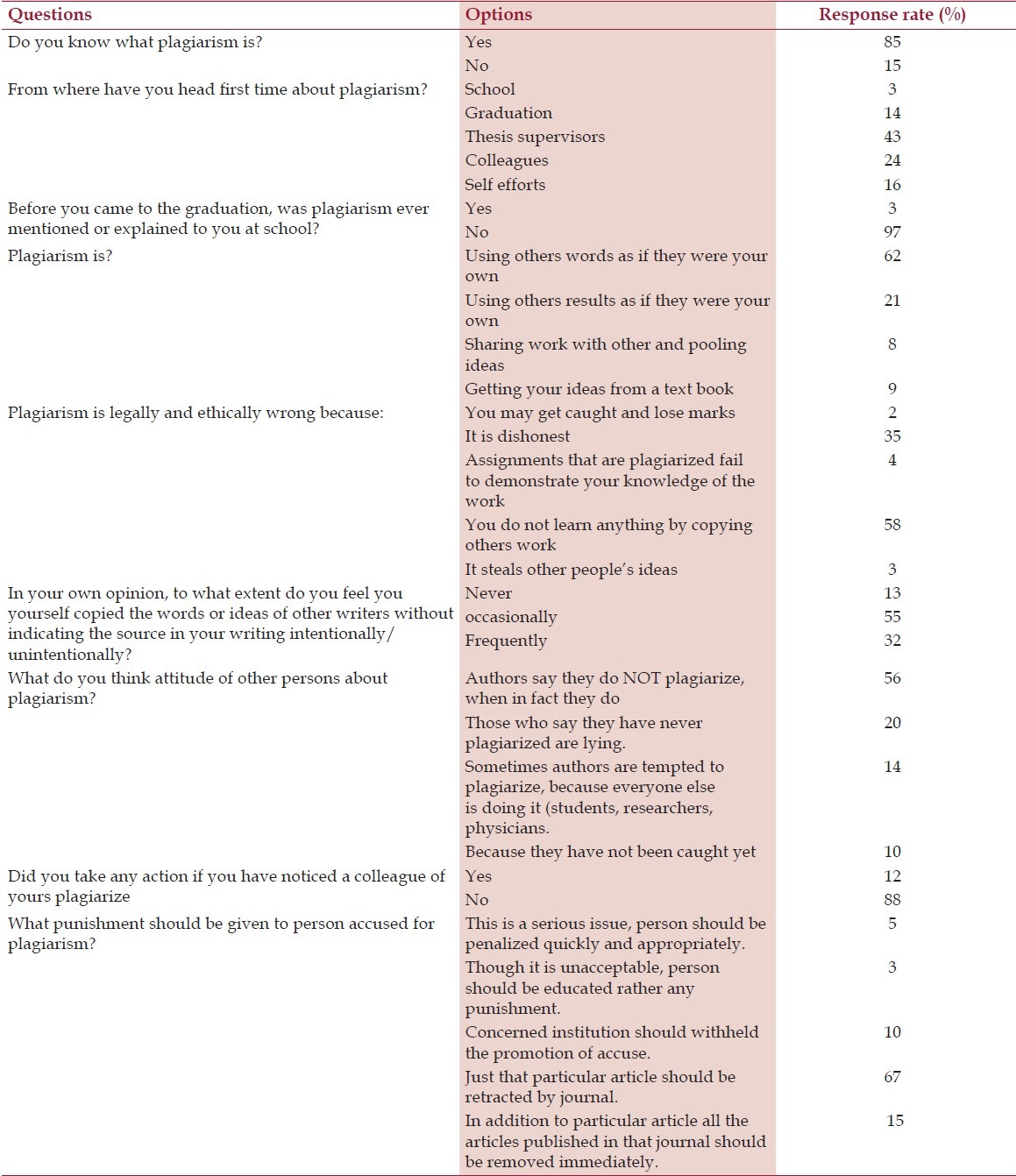
The questionnaire was re-evaluated and minor changes were made in questionnaire to make it more clear and understandable. After first pilot study, another pilot study was conducted on 30 other people. Reliability of questionnaire was estimated and the value of Cronbach's alpha coefficient came to be 0.76. Finally, 5000 dental professionals were randomly included in this study; the questionnaire having 14 questions was sent either via e-mails or by sending printed copies while maintaining anonymity of all the participants. No difference in age or academic achievements was taken into consideration for evaluation of results.
Statistical study
Statistical Package for Social Sciences (SPSS, version 14, Chicago, Illinois, USA) was used. Statistical analysis of the compiled data was done using 2-tailed t-test.
Results
Response of participants were collected. Distribution of answers to all questions was calculated and presented as percentage of subjects answering particular answer to each question. [Table 1]. Results showed that 85% of the participants in questionnaire knew about plagiarism. (P < 0.001**) The prevalence of committing plagiarism at least once ever was about 87%. (P < 0.001**).
Discussion
Results showed that 85% of the participants in questionnaire knew about plagiarism, a whopping 93% said that plagiarism was not ever mentioned to them in school before they came to graduation with nearly 43% reportedly heard about it for the first time from their thesis supervisors. It suggested us that there is lack of knowledge of plagiarism in developing minds of growing children, so authors have a opinion that they should be made aware of such unethical and immoral act in their school time to curb plagiarism at its root.
On being asked as to why they felt that plagiarism is ethically and legally wrong, 35% responded to the option that it is wrong because it is dishonest whereas 58% believe it is wrong because one does not learn anything by copying others work. Albeit, plagiarism is considered theft or stealing, it does not exist in a legal sense. In present scenario it is not mentioned in any current decree, either Criminal law criminal or Civil law (common law) civil. Plagiarism is an iniquitous competition and definitely a contravene of Moral rights (copyright law) moral rights because the accused is stealing ideas of some other person or presenting some other persons work by making his own without acknowledging the person.[5]
Eighty-five percent of the participants in the questionnaire said that plagiarism cannot be successfully avoided [Figure 1] citing various reasons such as there are n number of articles being published each year so it is not possible to keep a check on every single publication and that also at times unintentionally or unknowingly one might be indulging in plagiarism. Thirty-five percent people believe that their native language is not English so they need to consult other articles because they fall short of words to express their opinion correctly. Certainly, authors writing their maiden paper need guidance, which is not easily obtained. Undoubtedly, good writing of an article cannot compensate for a weak experiment.[6]
Figure 1.
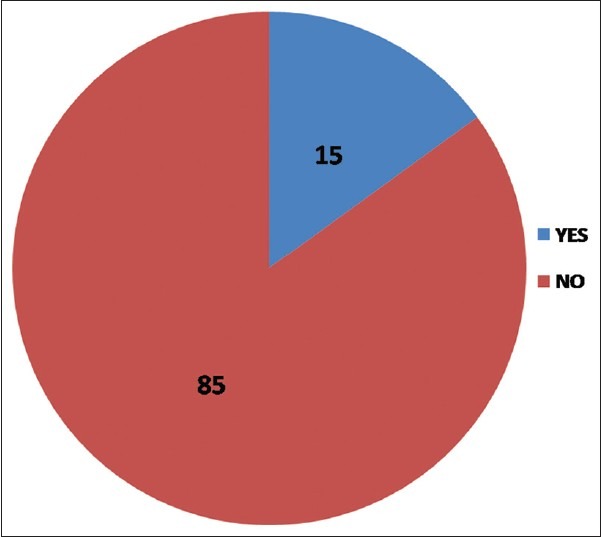
Pie chart representing opinion of participants to avoid plagiarism
Surprisingly it revealed that almost 55% of the participants had themselves indulged in plagiarism, either knowingly or unknowingly. [Figure 2] Therefore it seems that there is a generalized perception among dental professionals that plagiarism merely casts a reflection on oneself as well as on the original authors but really does not have a significant impact on fellow colleagues or university per se. Persons accused of plagiarism are not in a worrisome situation in plagiarizing contents because as of now in India there is no any authorized agency or department which deals with plagiarism. Plagiarism is sometimes unavoidable, especially when the author is writing first time in English. They have difficulty in expressing their ideas or using the idiom of science. Some authors believe it is a form of sycophancy to use the words of a guide, or that there is little harm in borrowing phrases that may describe findings better than more original words. Nonetheless, the outlook in science is that recycling of words without provenance is a crime.[7]
Figure 2.
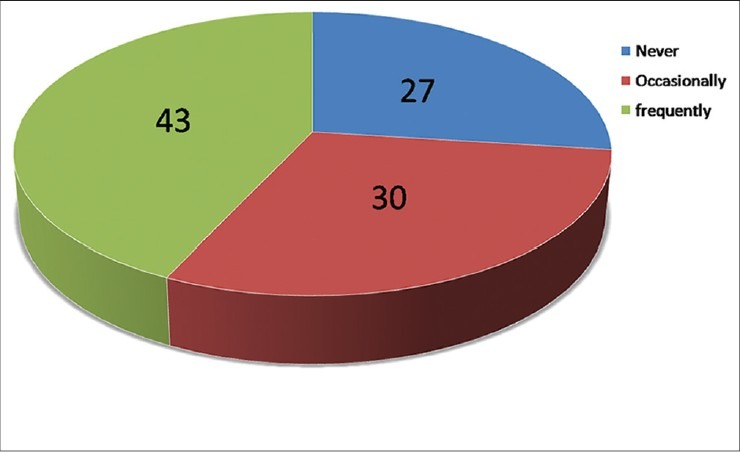
Pie diagram depicting percentage of participants who had indulged in plagiarism
In order to search for the answer as to why there is a high rate of plagiarism, it was revealed that pressure to publish is the largest reason (55% persons) driving academicians to plagiarize, and the lack of essence of writing in English (35%) was also a key factor accountable for increased rate of plagiarism in India. Lack of funds (35%) and inappropriate facilities (55%) for research work, were cited as two prime reasons for India lacking behind in the scientific world. As anywhere in the world, majority of the funding for research in India comes from the Central Government's Department of Science and Technology-DST and the Department of Biotechnology-DBT. Apart from these, life science sectors are funded by the Indian Council for Medical Research.[8] Research and innovation are the foundation for sustained growth. Governments should help to build environments in terms of grants, tax rebates and infrastructure thereby promoting innovations and development to control the growing myopia of new thoughts. Oversight and a lack of proper training for scientists have created the rise of plagiarism and research misconduct in India
If we consider publications in dentistry alone, India is ranked 10th in number of dental publications with 2296 publications with an H index (or Hirsch number is an index that attempts to measure both the productivity and impact of the published work of a scientist or scholar)[9] of “25”. The 1st and 2nd in ranking being US and U.K with 22969 and 8,069 publications respectively, also have a H-index of 137 and 92 respectively.[10] The point of concern here is that although the ranking of countries like Switzerland is lower than that of India, i.e., 14th with 1887 publications but still the H-index is way too high standing at a proud 77. Highest in quality of research is Switzerland while US is a close second. Countries like Chile, Kenya, Sri Lanka, Nepal, Ghana have a better quality of average publication as compared to India.[10] (based on number of citations). Increase in output (in number of publications) does not indicate increase in quality of average Indian publications. India is always among the toppers as far as quantity is concerned, but the quality is going down. More routine research works are shifted to India and more number of university and institutes are established, but still there are ‘Signs of Stagnation’[11], as it is an old saying that “You can put millions of farmers to cultivate but you need some real scientists to make green revolution”. Similarly, an upsurge in number of publications do not simply indicate an increased level of scientific research in the country and the true-life scenario is quiet worrisome.
29% of papers worldwide were retracted for some form of plagiarism[12] and only 6% of retraction was from India.[13] Some believe that India cannot emerge as a global player in science and technology until plagiarism is reduced.[14]
Self-plagiarism is the act of stealing words from one's own published work. There is a controversy on whether self-plagiarism actually amounts to scientific misconduct.[3,4,5,6,7,8,9,10,11,12,13,14] Surprisingly, 90% of participants felt that copying matter from one's own previous work should not be considered as plagiarism; and furthermore 93% wanted plagiarism to be allowed to some extent. [Figure 3] Self-plagiarism is not shoddier than laziness. Repeated self-plagiarism results in artificial elevation of the productivity of a researcher. Thus, a degree of deception is involved in self-plagiarism.[15] Because professional advancement and scientific reputation depend on research productivity, self-plagiarism is a form of theft from the scientific establishment. As a practical matter, some journals use a guideline that up to 30% of the words in a paper can be recycled by an author from a previous paper, but no data, whatsoever, can be recycled.[16]
Figure 3.
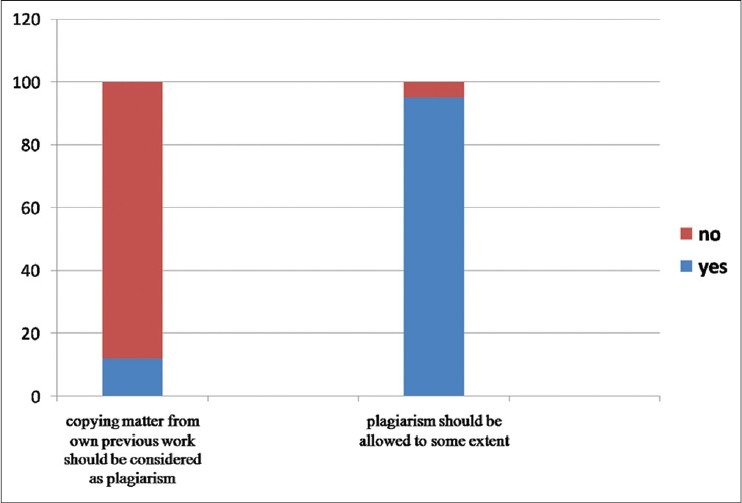
Column graph showing opinion on self-plagiarism, and if it should be allowed
When one goes through a new article, he/she expects it to be an original article and if there has been any type of self-plagiarism, expectations of the reader are breached. On the contrary, at times, it is unavoidable for an author not to use matter from previous work. In such a situation he should seek permission for reproduction from the copyright holder (if the copyright has been transferred to the publisher). He must cite the original book, chapter, or article properly to avoid being tagged as a self-plagiarist, thereby being transparent by providing proper citations.[3] In order to avoid such gross misconduct of plagiarism, there should be certain rules and norms of journals and institution, which they should abide. To our utter surprise a good part of participants (67%) wanted that retraction of the plagiarized article alone from the journal should be adequate punishment for a plagiarist, some (15%) believed that all articles in that journal should be removed, therefore bringing the role of journal editors under the scanner as well. [Figure 4] Unfortunately, even the editors of journals do not know how to deal with cases of plagiarism, which may be due to lack of any uniform law against it. If we really want to remove this curse from our scientific research environment, we have to catch it from the root cause by instilling a moral and ethical integrity in research and publication from school, as there is lack of considerable attitude and awareness among students as well as teachers. The accused person should be punished by retracting his article and penalized at the same time instead of retracting all his articles from that publication house because this will be immoral or unethical in under-considering original work of accused author and may also have detrimental after affects on the authors future interest in research and publication. Institutions should also take serious concern of this issue and give a disciplinary warning, in form of a written notice or by withholding the increment and promotions of accused person, if he/she has taken any benefit from it. Uniformity of law and stern actions should be adopted to remove plagiarism from its root and governments and research agencies should also provide necessary funds to motivate and reward the authors if India wants to compete with rest of the world and have a better research environment.[17,18]
Figure 4.
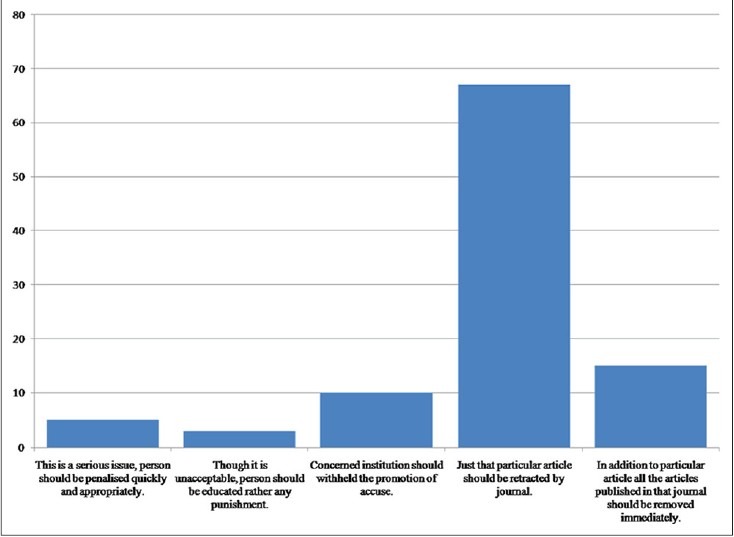
Bar graph showing opinion of participant that what punishment should be given to person accused for plagiarism
Conclusion
From our study, we conclude that plagiarism is present in dental professionals and that significant reduction can only be brought by awareness of objective check methods and stringent punishment. The attitude of dental professionals is actually worrisome and a great deal of importance of ethical medical writing needs to be promoted. Also, inconsistence in attitudes, indicates a lack of awareness and recognition of this act as wrong. There was also a general attitude in some instances towards giving socially desirable opinions, which is quite contradicting to the general trend being followed. To conclude, plagiarism and other forms of misconduct must be recognized and must not be tolerated.
Acknowledgement
We would like to thank all the dental professionals of north India who have contributed towards this survey and have given their valuable opinion.
Footnotes
Source of Support: Nil.
Conflict of Interest: None declared.
References
- 1.Sapatnekar SM. Plagiarism. J Assoc Physicians India. 2004;52:527–30. [PubMed] [Google Scholar]
- 2.Singh AJ. Plagiarising plagiarism. Indian J Community Med. 2007;32:1–3. [Google Scholar]
- 3.Broome ME. Self-plagiarism: Oxymoron, fair use, or scientific misconduct? Nurs Outlook. 2004;52:273–4. doi: 10.1016/j.outlook.2004.10.001. [DOI] [PubMed] [Google Scholar]
- 4.Lands R. Plagiarism is no crime. published by The Association of Illustrators (AOI); 1999. [Google Scholar]
- 5.Green SP. Plagiarism, norms, and the limits of theft law: Some observations on the use of criminal sanctions in enforcing intellectual property rights. Hastings Law J. 2002:167–241. [Google Scholar]
- 6.Kallestinova ED. How to write your first research paper. Yale J Biol Med. 2011;84:181–90. [PMC free article] [PubMed] [Google Scholar]
- 7.Mason PR. Plagiarism in scientific publications. J Infect Dev Ctries. 2009;3:1–4. doi: 10.3855/jidc.98. [DOI] [PubMed] [Google Scholar]
- 8.Research development office; grants for independent researchers. 2013. [Accessed April 4, 2013]. at http://www.ncbs.res.in/rdo/grants .
- 9.Hirsch JE. An index to quantify an individual's scientific research output. Proc Natl Acad Sci U S A. 2005;102:16569–72. doi: 10.1073/pnas.0507655102. [DOI] [PMC free article] [PubMed] [Google Scholar]
- 10.SC Imago, SJR - SC Imago Journal & Country Rank. 2007. [Accessed March 11, 2013]. at http://www.scimagojr.com .
- 11.Balaram P. Science in India: Signs of Stagnation. Curr Sci. 2002;82:193–4. [Google Scholar]
- 12.Steen RG. Retractions in the scientific literature: Is the incidence of research fraud increasing? J Med Ethics. 2011;37:249–53. doi: 10.1136/jme.2010.040923. [DOI] [PubMed] [Google Scholar]
- 13.Steen RG. Retractions in the scientific literature: Do authors deliberately commit research fraud? J Med Ethics. 2011;37:113–7. doi: 10.1136/jme.2010.038125. [DOI] [PubMed] [Google Scholar]
- 14.Steen RG. Writing for publication in a medical journal. Indian J Endocr Metab. 2012;16:899–903. doi: 10.4103/2230-8210.102988. [DOI] [PMC free article] [PubMed] [Google Scholar]
- 15.Self-plagiarism: Unintentional, harmless, or fraud? Lancet. 2009:374–664. doi: 10.1016/S0140-6736(09)61536-1. [DOI] [PubMed] [Google Scholar]
- 16.Special report: Taking on the cheats. Nature. 2005;435:258–9. doi: 10.1038/435258a. [DOI] [PubMed] [Google Scholar]
- 17.Bilić-Zulle L, Frković V, Turk T, Azman J, Petrovecki M. Prevalence of plagiarism among medical students. Croat Med J. 2005;46:126–31. [PubMed] [Google Scholar]
- 18.Zhang H. Cross Check: An effective tool for detecting plagiarism. Learn Publ. 2010;23:9–14. [Google Scholar]


